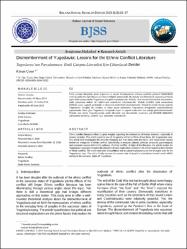| dc.contributor.author | Çınar, Kürşat | |
| dc.date.accessioned | 2019-04-11T07:10:15Z | |
| dc.date.available | 2019-04-11T07:10:15Z | |
| dc.date.issued | 2019 | |
| dc.identifier.uri | https://hdl.handle.net/20.500.11776/3149 | |
| dc.description.abstract | Etnik çatışma literatürü, insan doğasının ve sosyal davranışlarının bilhassa çeşitlilik gösteren toplumlarda motivasyonlarıyla ilgili bizlere çok önemli bilgiler sunmaktadır. Bu makale son dönemlerde yaşanmış en büyük çaplı etnik çatışmalardan Yugoslavya örneğini araştırmaktadır. Makale, ilkin etnisite literatürünü incelemekte, etnik çatışmanın mikro- ve makro-bazlı nedenlerini irdelemektedir. Makale özellikle etnik çatışmaların kültürel, siyasi, yapısal, psikolojik ve ekonomik nedenlerini incelemektedir. Makale bu teorik altyapı ışığında Yugoslavya örneğini ele almakta ve bahsi geçen nedenlerin Yugoslavya örneğindeki karşılaştırmasını yapmaktadır. Buna göre Yugoslavya örneğinde siyasi ve yapısal nedenlerin öne çıktığı gözlemlenmektedir. Makale son olarak Yugoslavya’nın ardılı ülkelerde son dönemlerde insanların çok-etnisiteli toplumlara yaklaşımını inceleyip, konuyla ilgili çıkarımlar yapmaktadır. | en_US |
| dc.description.abstract | Ethnic conflict literature offers us great insights regarding the motivations of human behavior, especially in diverse societies. This article explores one of the greatest ethnic conflicts of our times, the Yugoslavian case. The article first investigates the ethnicity literature and then delves into the micro- and macro-level reasons behind the instigation of ethnic conflict. Specifically, it analyzes cultural, political, structural, psychological, and economic reasons behind the outbreak of ethnic conflict. In light of the literature, the article studies the Yugoslavian case and compares the strengths of each explanation covered in the article regarding the initiation of ethnic conflict. The article maintains that political and structural explanations are the strongest ones for the Yugoslavian case. The article finally assesses the current state of people’s orientations toward a multi-ethnic society in the successor states of Yugoslavia. | en_US |
| dc.language.iso | eng | en_US |
| dc.publisher | Namık Kemal Üniversitesi | en_US |
| dc.rights | info:eu-repo/semantics/openAccess | en_US |
| dc.subject | Etnik Çatışma | en_US |
| dc.subject | Yugoslavya | en_US |
| dc.subject | Çok-Uluslu Devletler | en_US |
| dc.subject | Ethnic Conflict | en_US |
| dc.subject | Yugoslavia | en_US |
| dc.subject | Multi-Ethnic Societies | en_US |
| dc.title | Dismemberment of Yugoslavia: Lessons for the Ethnic Conflict Literature | en_US |
| dc.title.alternative | Yugoslavya’nın Parçalanması: Etnik Çatışma Literatürü İçin Çıkarılacak Dersler | en_US |
| dc.type | article | en_US |
| dc.relation.ispartof | Balkan Sosyal Bilimler Dergisi | en_US |
| dc.department | Tekirdağ Namık Kemal Üniversitesi Dergileri | en_US |
| dc.identifier.volume | 8 | en_US |
| dc.identifier.issue | 15 | en_US |
| dc.identifier.startpage | 15 | en_US |
| dc.identifier.endpage | 27 | en_US |
| dc.relation.publicationcategory | Makale - Ulusal Hakemli Dergi - Başka Kurum Yazarı | en_US |



















